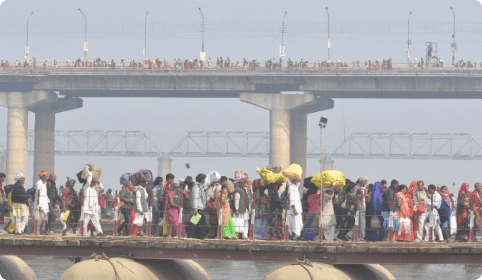In the sacred tapestry of the Maha Kumbh Mela, where millions congregate to partake in a spiritual spectacle, there exists a profound yet lesser-known facet—Kalpavas. This spiritual sojourn within the vast expanse of the Maha Kumbh Mela holds a unique significance, offering seekers a chance to delve deeper into the realms of devotion, austerity, and the pursuit of spiritual awakening. As we unravel the layers of Kalpavas, we discover a journey that transcends the ordinary, inviting pilgrims to immerse themselves in a celestial realm of introspection and divine connection.

The term "Kalpavas" derives its roots from Sanskrit, where "Kalpa" signifies a cosmic aeon, and "Vas" translates to dwelling or residence. In the context of the Maha Kumbh Mela, Kalpavas represents a sacred retreat, a period of intense spiritual discipline, and a devoted dwelling in the pursuit of higher consciousness. It is a unique opportunity for pilgrims to engage in practices that transcend the ordinary routines of daily life, fostering a deepened connection with the divine.
The tradition of Kalpavas finds its roots in ancient Hindu scriptures, where saints and ascetics embarked on prolonged periods of austere living to attain spiritual prowess. In the context of the Maha Kumbh Mela, Kalpavas unfolds as a dedicated retreat within the larger pilgrimage, providing an immersive experience for those seeking profound spiritual transformation.
Kalpavas is not merely a physical retreat; it is a commitment to a set of rigorous rituals and disciplines that pave the way for spiritual elevation. Those participating in Kalpavas dedicate themselves to a life of simplicity, austerity, and devout practices, reflecting the essence of traditional asceticism.
In the vastness of the Maha Kumbh Mela, where the multitude engages in various rituals and celebrations, Kalpavas stands as a distinct spiritual retreat—an intimate journey within the grand pilgrimage. It is a sacred space where seekers willingly embrace austerity, rituals, and devotion, forging a profound connection with the divine. Kalpavas is not just a retreat; it is an opportunity for participants to transcend the mundane, purify their beings, and attain a state of spiritual transcendence.
As the rhythmic chants and sacred fires illuminate the banks of the holy rivers, Kalpavas becomes a beacon of spiritual aspiration, inviting pilgrims to embark on a celestial journey within. In the quietude of devotion and the discipline of ascetic living, participants discover the sublime beauty of the inner realms—a beauty that transcends the temporal and connects with the eternal. Kalpavas, within the expansive canvas of the Maha Kumbh Mela, becomes a sacred pilgrimage of the soul—an odyssey into the realms of the divine.